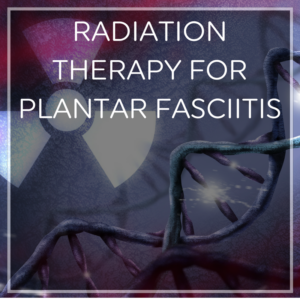 Radiation therapy, also known as radiotherapy, is a medical treatment that uses a targeted dose of radiation (a type of energy) to break down certain types of tissue in the human body.
Radiation therapy, also known as radiotherapy, is a medical treatment that uses a targeted dose of radiation (a type of energy) to break down certain types of tissue in the human body.
Higher doses of radiation are commonly used to shrink cancerous tumors. Lower doses of radiation, on the other hand, can be used to break up scarring and damaged tissue in the ligaments of the heel and arch.
An important study by Dr. Robert Michael Hermann, MD, found that radiation therapy is an effective non-invasive treatment method for a high percentage of plantar fasciitis patients. Here’s what you need to know before you decide to give radiotherapy a try!
What Is Radiation Therapy (Radiotherapy)?
Radiation therapy uses the same kind of energy that’s used in X-rays to damage or destroy certain kinds of tissue.
While radiation therapy might sound a little intimidating–since it’s the same type of therapy used to treat breast and prostate cancer patients–you should know that the radiation therapy for Plantar Fasciitis is delivered in a much lower dose.
Radiation is measured in units of (Gy). Cancerous tumors are usually targeted with a dose of approximately 60 or 70 Gy per treatment (high enough to break down the DNA and molecules of a cancerous tumor). Plantar Fasciitis, on the other hand, is usually targeted with a dose of only 3 Gy–about 20 times less.
What to Expect From Radiotherapy for Plantar Fasciitis

One of the most common concerns about radiotherapy for Plantar Fasciitis is the potential side effects. Many people are aware of the unpleasant side effects that sometimes happen from higher-dose, tumor-targeting radiation, which can include hair loss, fatigue, and skin irritation.
However, it’s important to understand that the tiny dose of radiation delivered during radiotherapy for Plantar Fasciitis won’t cause these side effects. Radiotherapy itself is very quick and completely painless, and may take as little as five minutes.
In the days following radiotherapy for Plantar Fasciitis, you may notice a small amount of swelling or redness, which will pass quickly. However, you will be able to walk as you normally do. (Remember to wear orthotics to support your healing arch and avoid reinjury!)
In general, radiotherapy treatments for Plantar Fasciitis are administered once or twice a week, for a course of six to eight weeks. The cost of radiation therapy will vary depending on your insurance coverage, but many insurance companies cover the procedure, and you may only be responsible for a copay.
Is Radiation Therapy Effective for Plantar Fasciitis?
The reason radiotherapy is effective at destroying cancerous tumors is that the targeted radiation completely completely destroys cancer cells. This high dose of radiation will, of course, also damage normal cells. However, these normal cells have the ability to repair themselves–while the cancer cells do not.
When it comes to Plantar Fasciitis, low doses of radiation break down painful scar tissue in the heel and arch. The small dose of radiation can also trigger a healing response, as the cells that have just sustained some damage repair themselves.
In a recent study by Dr. Hermann MD, 200 patients were treated with radiation therapy for Plantar Fasciitis. Three months after the course of radiation therapy, almost 70% were pain free or had very little pain. At 54 months, a little over 60% were still pain-free or almost pain free.
Are You a Good Candidate for Radiation Therapy?
While most cases (over 90%) of Plantar Fasciitis respond well to conservative treatments such as orthotics, physical therapy, icing, and stretching, other cases are more stubborn.
For chronic, complex, or debilitating cases of Plantar Fasciitis, surgery may seem like the only option left. But if you’ve tried conservative options without success, noninvasive radiation therapy can be a great option before you undergo the expense, pain, and recovery of Plantar Fasciitis surgery.
If you’re considering radiation therapy for Plantar Fasciitis, talk to your doctor about your questions and concerns–especially if you’re looking at having surgery. While everyone’s health and circumstances are different, radiation therapy shows a great deal of promise as a less expensive, less invasive alternative to surgery.




I have severe heel pain. I have tried all conventions non-surgery processes. Nothing works. Foot surgeon recommends surgery. I’m 91 yrs old, Cardiologist and GP are opposed to surgery. Can’t find Dr. in Chattanooga, Tn. that offers radiation therapy or another type non invasive treatments. I’m 91 years of age. Bad back, bad feet – balance is bad because I can’t walk balanced.Any suggestions or name of any doctor in Chattanooga T area. that provides services other than invasive surgery.
is there a doctor in Orlando, Florida that offers radiation therapy. Thanks.
I have been dealing with plantar fasciitis for 10 months and three different podiatrists and nothing works…I even went for physical therapy and accupuncture and 8 shots of cortisone, I have had it wrapped and did the rolling of the foot and used ice many times..they did xrays to check for bone spurs and none were evident….I need some help and I must find a doctor that would consider low dose radiotherapy in Bergen county….I am no longer living the way I should because of this heel problem….Help me please……I am in Northern Bergen County……
Did you find anyone in Northern NJ?
List of doctors in America that offer Radiation Therapy for Plantar Fasciitis please.
The radiation oncologists are the doctors who administer radiation. More likely than not, there is one near you. You can go on google and search “Radiation Oncologist near me” and then call their office to schedule a consultation. If not, call your local hospital, and ask if they have a radiation oncology department; if not, ask where’s the nearest one.